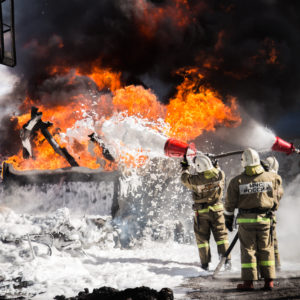Firefighter Foam Caused Testicular Germ Cell Carcinoma Diagnosis, Lawsuit Alleges

A product liability lawsuit filed against a number of different chemical and safety equipment manufacturers indicates that a Louisiana man developed testicular cancer from exposure to firefighter foam that was used throughout his career working at an airport.
The complaint (PDF) was brought by Patrick Williams and his wife in the U.S. District Court for the District of South Carolina on January 22, indicating he was regularly exposed to toxic chemicals contained in aqueous film-forming foams (AFFF), known as per and polyfluoroalkyl substances (PFAS).
Williams worked as a firefighter at Alexandria International Airport in Louisiana from 1995 to 2002, where AFFFs were routinely used during training exercises and in response to certain fuel-based fires.

Learn More About
Exposure to firefighting foam chemicals may result in an increased risk of cancer for firefighters, military and airport personnel.
Learn More About this Lawsuit SEE IF YOU QUALIFY FOR COMPENSATIONThe lawsuit presents claims against 3M Company, DuPont, BASF Corporation, and other companies involved in the manufacturing, distribution and sale of AFFF that contained PFAS chemicals, which are now known to build up in the body and increase the risk of cancer and other health problems. PFAS chemicals contained in AFFF may take thousands of years to degrade, and past studies have shown their ability to enter and stay in the environment and human body through the air, dust, food, soil, and water.
Williams alleges that the defendants knew for decades about the risk these chemicals posed to human health and the environment, indicating the exposure resulted in his diagnosis of left testicular germ cell carcinoma, resulting in the need for a radical orchiectomy to remove his left testicle.
“Defendants could have manufactured, marketed, and sold alternative designs or formulations of products that did not contain harmful fluorochemicals,” the lawsuit states. “These alternative designs and/or formulations were available, practical, and technologically feasible.”
The toxic chemicals were first introduced into the manufacturing industry in the 1940’s, because of their ability to resist heat, grease, stains, and water. However, since then the chemicals have been linked to a myriad of adverse health effects including liver damage, thyroid disease, decreased fertility, high cholesterol, obesity, hormone suppression, and cancer.
Williams’ complaint joins a number of firefighting foam lawsuits filed across the nation, all raising similar allegations of the manufacturers failing to warn of the dangerous PFAS, which have resulted in those exposed to develop testicular cancer, kidney cancer, pancreatic cancer and other injuries.
Due to the growing number of lawsuits over firefighting foam injuries brought throughout the federal court system, centralized pretrial proceedings have been established in the U.S. District Court for the District of South Carolina, where the parties are engaging in coordinated discovery and preparing for a series of early “bellwether” trials designed to gauge how juries are likely to respond to certain evidence and testimony that will be repeated in claims brought by firefighters nationwide.
Get more articles like this sent directly to your inbox.
"*" indicates required fields






0 Comments